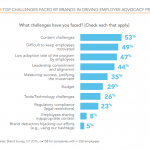Smarp vs. Bambu: Which Employee Advocacy Platform Is Better?
— October 24, 2017

Online marketing isn’t just about getting traffic. If you want to generate qualified leads, you need to attract the right audience members, and you need the ability to compel your site visitors to take action. For that to happen, you must also establish familiarity, raise your brand´s authoritative message, and foster trust in your brand.
Most experienced marketers advise people to launch an outreach strategy to help cover these bases. The common route is to pitch guest posting opportunities and social media amplification partnerships to the popular bloggers and influencers in your niche.
Sure, these high-profile individuals can bring your brand a ton of exposure. However, before you get their attention, you’d most likely need to send hundreds of outreach emails and craft dozens of authoritative content items under your brand name.
Sounds tedious and expensive, right? Don’t worry – having a high-profile individual from outside your organization vouch for you isn’t the only way to win your audience’s trust.
By turning to employee advocacy, you can make your brand more relatable, likable and trustworthy without the frustrations and efforts that involve outreach.
It works by having your staff post and share content about your company through their own social media accounts.
Approximately 84% of people seek out recommendations from their peers before making purchase decisions, which is why employees usually generate stronger leads than corporate social media accounts. Furthermore, the average individual’s social media following is tiny compared to brands. But cumulatively, the potential reach for your entire team’s personal accounts combined is likely many times greater than your company’s branded social presences.
In this post, we’ll compare two of the biggest employee advocacy platforms (Smarp and Bambu) to help you decide which one is perfect for your brand. Let’s get to it.
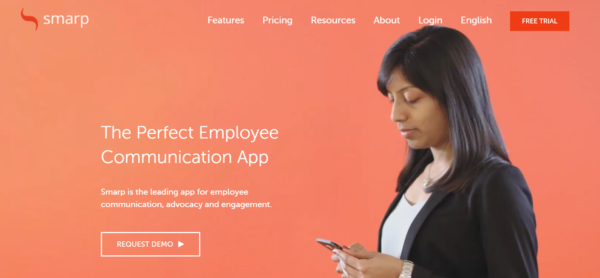
A successful employee advocacy campaign requires excellent internal communications. After all, encouraging employees to put in the extra work needed is not an easy task.
Smarp makes sure you get the foundations right. Not only does it give your employees a virtual hub for communication, collaboration, and friendly competition, it also enables them to stay in-tune with your brand’s content streams.
Key Features
Here is a quick rundown of Smarp’s main features:
- The News Feed
With Smarp, employees can easily discover and share company news, inspirational stories, and other fun content. It functions almost like a category-indexed internal social network, allowing users to comment and react to each other’s posts. - Gamification
Smarp offers gamification features to keep employees engaged and motivated to participate in advocacy — most notably the leaderboard system, where employees can compete, rack up points and collect rewards. - Analytics
Making data-driven decisions is the key to constant growth. Smarp can also help you with this by making analytics data easily accessible to everyone in your company. - Third-Party Integrations
Finally, Smarp is highly expandable, with the help of third-party apps, social networks, and various integrations.
Launching an Advocacy Program with Smarp
After logging in to Smarp, the first thing your employees will see is the news feed. Here, they can easily discover content, view their advocacy performance (presented as a “SmarpScore”) and monitor coworkers’ activity via the leaderboard.
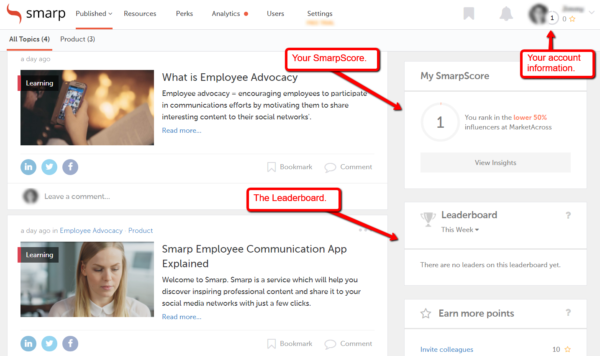
As an admin, your first goal is to set up automatic content fetching by going to “Settings” and then clicking the “Content & Targeting” tab. Currently, you can specify an RSS feed as well as social media accounts on Facebook, Twitter and LinkedIn sources for automated aggregation of content for employees to see in their feeds as suggested shares.
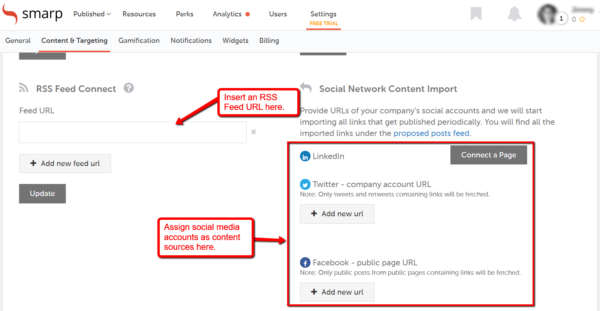
By specifying your main content sources, your employees will always have a stream of content that they can share with their followers. They only need to click one of the sharing buttons found under each item to schedule a post.
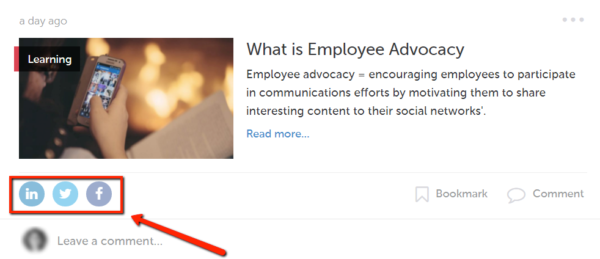
Of course, you can also manually share content by pasting a link at the top of the news feed. You can also create a note, which is specifically more effective for internal communications.
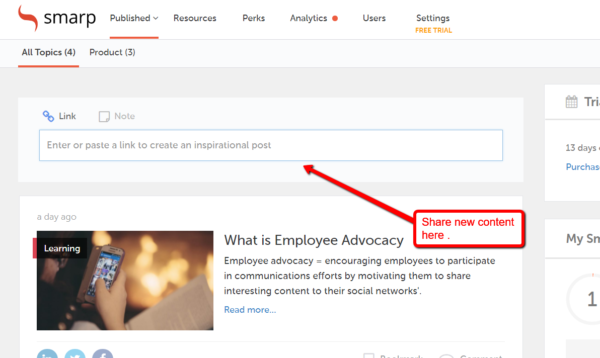
Incentivizing Advocacy
Gamification is one of the main selling points of Smarp, and it’s highly effective for compelling employees to promote your brand.
To start, navigate to “Settings” and then click the “Gamification” tab to configure how points and perks are earned.
Simply adjust settings like the number of points earned per audience click, who’s in charge of handing out perks and so on.
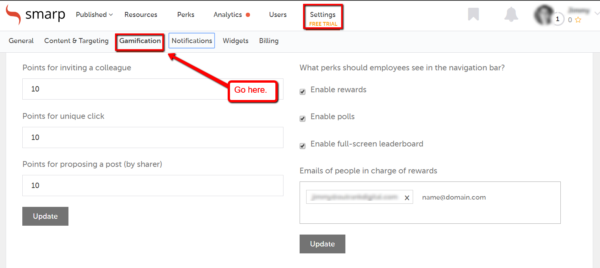
Once you’re all set, you can easily create rewards by selecting “Perks” in the main menu. Just click “New Reward,” and edit the title, description, image, and required points.
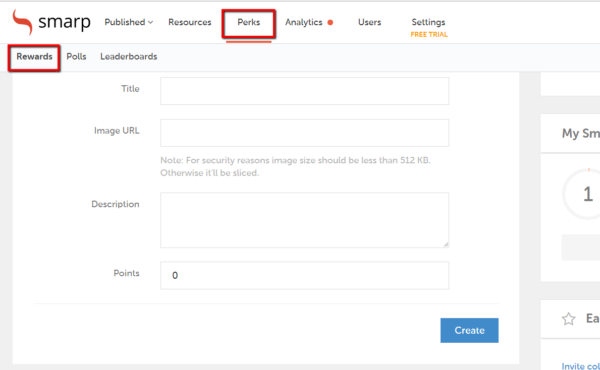
Smarp’s platform is all about making employee advocacy an “everyday thing” in your company. It does look and function like a social network, which is why employees should have no problem checking in every single day.
Generating Reports
The way Smarp’s “Analytics” page is laid out is very easy to understand.
Despite the page’s abundance of crucial data that users can review to have a better understanding of their campaigns’ performance, the page isn’t overwhelming at all.
After clicking the “Analytics” tab from the main menu, the users will then be able to see an overview of their team’s activity and performance.
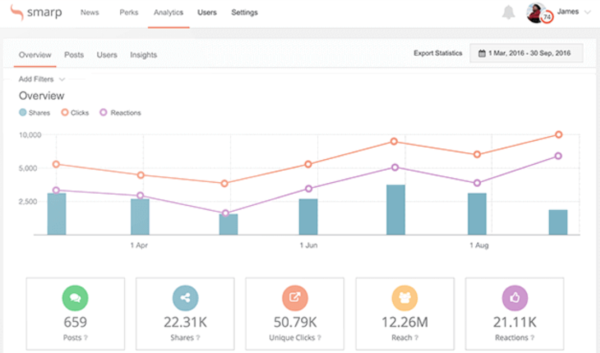
In addition to the “Overview” section, the “Analytics” page will also show you a few other key data points, including:
- User Engagement
- Network Activity Breakdown
- Potential Reach
To get an even better feel of your campaign’s performance, you can look into the “Posts” and “Users” tab, as well.

You can also fine-tune the reports that you’re seeing by using Smarp’s filters.
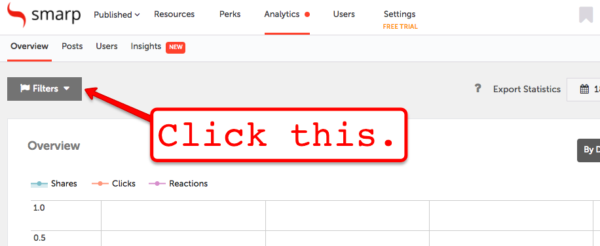
Overall, Smarp’s reporting feature is very insightful and intuitive.
How the simplicity of the interface and intuitiveness of the platform, even a total beginner should be able to navigate the page and understand what’s working in his or her company’s employee advocacy program, what types of content drive the most impact, and which team members wield the most influence.

Just like Smarp, Bambu aims to make advocacy a breeze for your employees. This employee advocacy platform operates under the auspices of Sprout Social, a comprehensive social media management app.
Key Features
Here is a quick glance at Bambu’s main features:
- Easy Content Curation and Distribution
Bambu offers user-friendly curation and distribution features. Network integrations for Facebook, LinkedIn and Twitter also exist to streamline your team’s sharing efforts. - Customizable Campaigns
Unlike Smarp, which makes employee advocacy an ongoing activity, Bambu allows you to build customized, individual campaigns. There is even a module for creating curated weekly newsletters with the top selections for suggested sharing. - Content Analysis
To help refine your content strategy over time, Bambu can provide you with a wealth of insights regarding content performance.
Launching an Advocacy Program with Bambu
Simplicity is the key to Bambu’s approach. Their main goal is to encourage employees to share content by removing friction points along the content stream.
The “Stories” section is the Bambu equivalent of Smarp’s news feed. It segments content into three categories: stories, scheduled and shared.
This is what the main Bambu Stories section look like to employees:
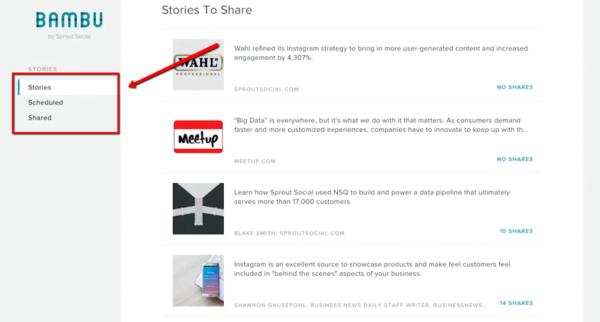
Clicking on any post will load up the content along with the necessary social sharing buttons. These can be found next to the “share this story” prompt.
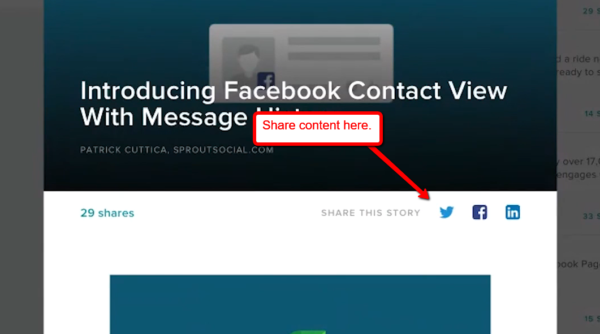
The content consumption and sharing experience remain the same for administrators. However, they gain complete access to other areas of Bambu, such as “Reports” and the “Add new story” button.
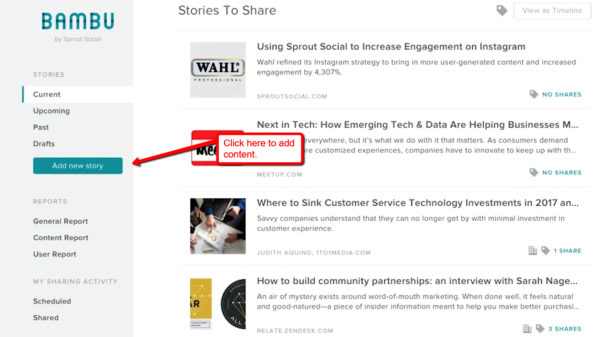
Unfortunately, only administrators can add content to the Bambu stories feed. On the plus side, there are a few noteworthy features, such as the ability to pin content at the very top of the feed, as well as the start and end dates for posts.
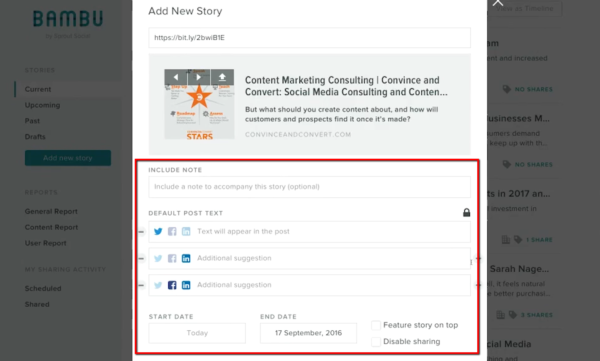
Generating Reports
Finally, Bambu can help you adjust and improve your advocacy campaign over time with the help of reports.
In the “Reports” section, you can review insights on your team, your content, and general campaign metrics.
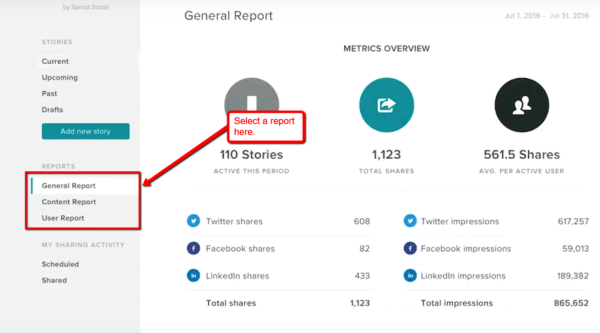
The reports are fully interactive and provide even more information if you hover over them with your mouse. Content and user reports can also be exported as CSV files for sharing with the rest of your team.
Conclusion
Smarp clearly has the advantage when it comes to compelling employees to engage with one another and advocate for your brand thanks to its gamification system. In addition, the wider array of integrated social networks and a focus on internal communications.
While Bambu does have a handful of unique features that can help with employee advocacy, there is a huge discrepancy between the privileges of regular users and administrators. Ultimately, Bambu is a less of an open platform, whereas Smarp cultivates internal communications even more by letting employees submit content for admins to approve for pushing to the feed.
Bambu is also quite limited in terms of expandability, whereas Smarp can be linked with various third-party services like WordPress, Dropbox, Slack and Evernote.
With gamification, expandability, and the community factor in mind, Smarp is definitely a cut above Bambu. But don’t take our word for it. Why not give each platform a spin and decide yourself?
Business & Finance Articles on Business 2 Community
(139)







